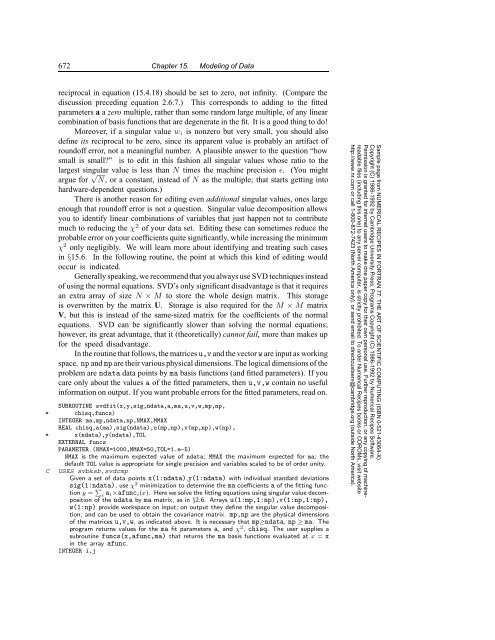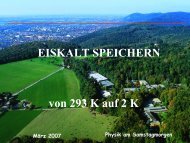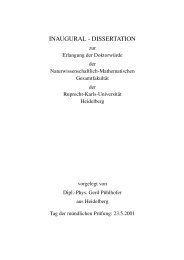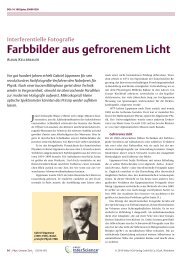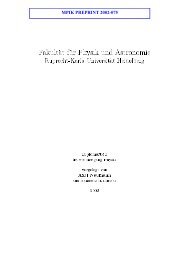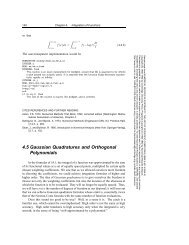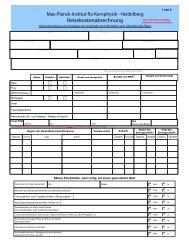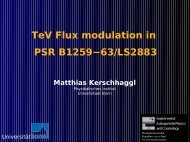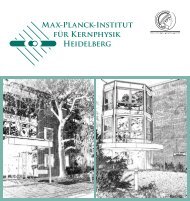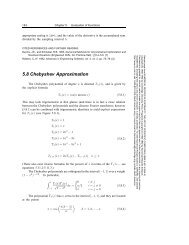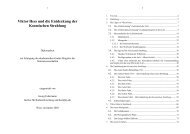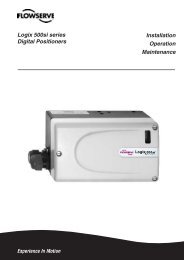15.4 General Linear Least Squares
15.4 General Linear Least Squares
15.4 General Linear Least Squares
Create successful ePaper yourself
Turn your PDF publications into a flip-book with our unique Google optimized e-Paper software.
672 Chapter 15. Modeling of Data<br />
reciprocal in equation (<strong>15.4</strong>.18) should be set to zero, not infinity. (Compare the<br />
discussion preceding equation 2.6.7.) This corresponds to adding to the fitted<br />
parameters a a zero multiple, rather than some random large multiple, of any linear<br />
combination of basis functions that are degenerate in the fit. It is a good thing to do!<br />
Moreover, if a singular value wi is nonzero but very small, you should also<br />
define its reciprocal to be zero, since its apparent value is probably an artifact of<br />
roundoff error, not a meaningful number. A plausible answer to the question “how<br />
small is small?” is to edit in this fashion all singular values whose ratio to the<br />
largest singular value is less than N times the machine precision ɛ. (You might<br />
argue for √ N, or a constant, instead of N as the multiple; that starts getting into<br />
hardware-dependent questions.)<br />
There is another reason for editing even additional singular values, ones large<br />
enough that roundoff error is not a question. Singular value decomposition allows<br />
you to identify linear combinations of variables that just happen not to contribute<br />
much to reducing the χ 2 of your data set. Editing these can sometimes reduce the<br />
probable error on your coefficients quite significantly, while increasing the minimum<br />
χ 2 only negligibly. We will learn more about identifying and treating such cases<br />
in §15.6. In the following routine, the point at which this kind of editing would<br />
occur is indicated.<br />
<strong>General</strong>ly speaking, we recommend that you always use SVD techniques instead<br />
of using the normal equations. SVD’s only significant disadvantage is that it requires<br />
an extra array of size N × M to store the whole design matrix. This storage<br />
is overwritten by the matrix U. Storage is also required for the M × M matrix<br />
V, but this is instead of the same-sized matrix for the coefficients of the normal<br />
equations. SVD can be significantly slower than solving the normal equations;<br />
however, its great advantage, that it (theoretically) cannot fail, more than makes up<br />
for the speed disadvantage.<br />
In the routine that follows, the matrices u,v and the vector w are input as working<br />
space. np and mp are their various physical dimensions. The logical dimensions of the<br />
problem are ndata data points by ma basis functions (and fitted parameters). If you<br />
care only about the values a of the fitted parameters, then u,v,w contain no useful<br />
information on output. If you want probable errors for the fitted parameters, read on.<br />
SUBROUTINE svdfit(x,y,sig,ndata,a,ma,u,v,w,mp,np,<br />
* chisq,funcs)<br />
INTEGER ma,mp,ndata,np,NMAX,MMAX<br />
REAL chisq,a(ma),sig(ndata),u(mp,np),v(np,np),w(np),<br />
* x(ndata),y(ndata),TOL<br />
EXTERNAL funcs<br />
PARAMETER (NMAX=1000,MMAX=50,TOL=1.e-5)<br />
NMAX is the maximum expected value of ndata; MMAX the maximum expected for ma; the<br />
default TOL value is appropriate for single precision and variables scaled to be of order unity.<br />
C USES svbksb,svdcmp<br />
Given a set of data points x(1:ndata),y(1:ndata) with individual standard deviations<br />
sig(1:ndata), useχ2minimization to determine the ma coefficients a of the fitting function<br />
y = <br />
i ai×afunci(x). Here we solve the fitting equations using singular value decomposition<br />
of the ndata by ma matrix, as in §2.6. Arrays u(1:mp,1:np),v(1:np,1:np),<br />
w(1:np) provide workspace on input; on output they define the singular value decomposition,<br />
and can be used to obtain the covariance matrix. mp,np are the physical dimensions<br />
of the matrices u,v,w, as indicated above. It is necessary that mp≥ndata, np ≥ ma. The<br />
program returns values for the ma fit parameters a, andχ2 , chisq. The user supplies a<br />
subroutine funcs(x,afunc,ma) that returns the ma basis functions evaluated at x = x<br />
in the array afunc.<br />
INTEGER i,j<br />
Sample page from NUMERICAL RECIPES IN FORTRAN 77: THE ART OF SCIENTIFIC COMPUTING (ISBN 0-521-43064-X)<br />
Copyright (C) 1986-1992 by Cambridge University Press. Programs Copyright (C) 1986-1992 by Numerical Recipes Software.<br />
Permission is granted for internet users to make one paper copy for their own personal use. Further reproduction, or any copying of machinereadable<br />
files (including this one) to any server computer, is strictly prohibited. To order Numerical Recipes books or CDROMs, visit website<br />
http://www.nr.com or call 1-800-872-7423 (North America only), or send email to directcustserv@cambridge.org (outside North America).


